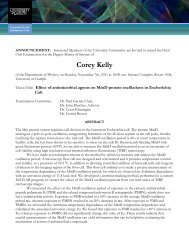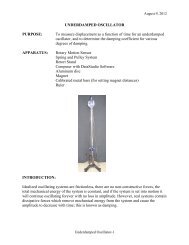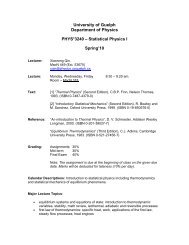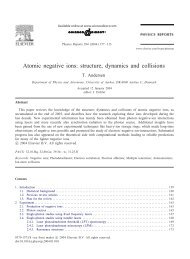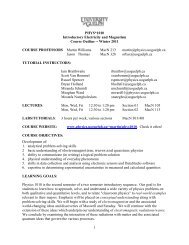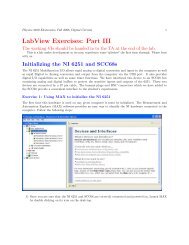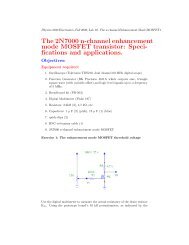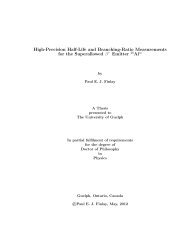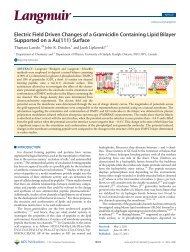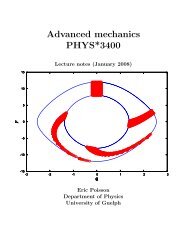Geant4 Simulations for the Radon Electric Dipole Moment Search at
Geant4 Simulations for the Radon Electric Dipole Moment Search at
Geant4 Simulations for the Radon Electric Dipole Moment Search at
You also want an ePaper? Increase the reach of your titles
YUMPU automatically turns print PDFs into web optimized ePapers that Google loves.
<strong>for</strong> perfectly aligned nuclei with integer nuclear spin P(m = 0) = 100%, where P is<br />
<strong>the</strong> popul<strong>at</strong>ion of <strong>the</strong> m-st<strong>at</strong>es. Polariz<strong>at</strong>ion, on <strong>the</strong> o<strong>the</strong>r hand, has P(m = J) >><br />
P(m ≠ J) and P(m = J) = 100% <strong>for</strong> perfect polariz<strong>at</strong>ion. Finally, orient<strong>at</strong>ion is <strong>the</strong><br />
completely general case, it can refer to any non-uni<strong>for</strong>m popul<strong>at</strong>ion of m-st<strong>at</strong>es. In<br />
<strong>the</strong> RnEDM simul<strong>at</strong>ions <strong>the</strong> m-st<strong>at</strong>es are tracked <strong>at</strong> each step, thus <strong>the</strong>se popul<strong>at</strong>ions<br />
are known exactly. Given this in<strong>for</strong>m<strong>at</strong>ion we can described any degree of orient<strong>at</strong>ion<br />
using Yamazaki’s <strong>the</strong>ory (see Appendix B <strong>for</strong> <strong>the</strong> MATLAB version of <strong>the</strong> γ-ray<br />
angular distribution code).<br />
InYamazaki’snot<strong>at</strong>ion,<strong>the</strong>angular-distributionfunction<strong>for</strong><strong>at</strong>ransitionJ i → J f ,<br />
where J is defined as <strong>the</strong> spin of <strong>the</strong> nuclear st<strong>at</strong>e, is expressed as<br />
W(θ) = 1+A 2 P 2 (cosθ)+A 4 P 4 (cosθ) , (3.11)<br />
where A k are <strong>the</strong> angular-distribution coefficients, P k are Legendre polynomials, and<br />
θ is <strong>the</strong> angle of emission rel<strong>at</strong>ive to <strong>the</strong> alignment axis. For fully aligned nuclei, <strong>the</strong><br />
angular-distribution coefficients are given <strong>the</strong> not<strong>at</strong>ion A max<br />
k . For this ideal case,<br />
A max<br />
k = 1<br />
1+δ 2 {<br />
fk (J j ,L 1 ,L 1 ,J i )+2δf k (J j ,L 1 ,L 2 ,J i )+δ 2 f k (J j ,L 2 ,L 2 ,J i ) } , (3.12)<br />
where δ is <strong>the</strong> mixing r<strong>at</strong>io (defined in Equ<strong>at</strong>ion 3.3) and<br />
f k ≡ B k (J i )F k (J f ,L 1 ,L 2 ,J i ) . (3.13)<br />
The term f k can be broken up into a st<strong>at</strong>istical tensor B k (J),<br />
⎧<br />
⎪⎨ (2J +1) 1/2 (−1) J (J0J0|k0) <strong>for</strong> integral spin,<br />
B k (J) =<br />
and (3.14)<br />
⎪⎩ (2J +1) 1/2 (−1) J−1 2(J 1J 1|k0) <strong>for</strong> half-integral spin. 2 2<br />
F k (J f ,L 1 ,L 2 ,J i ) ≡ (−1) J f−Ji−1 [ (2L 1 +1)(2L 2 +1)(2J i +1) ] 1/2<br />
×(L 1 1L 2 −1|k0)W(J i J i L 1 L 2 ;kJ f ) , (3.15)<br />
50



